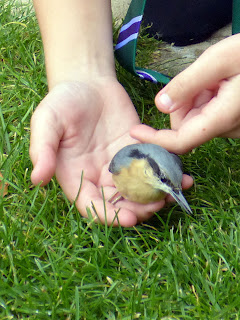Saturday, 29 September 2012
Male Bullfinch Sighting
The return of the Male Bullfinch, absent through most of the summer from our garden is a welcome sight. It has been spotted twice today, once early in the morning and again late in the afternoon. Bullfinches are notoriously shy and elusive and will fly off at the slightest disturbance, so we were only able to get a picture through the glass of the upstairs window - so the image quality is a little compromised. Within 5 minutes the Marsh Tit had arrived on the seed tray too! Two rare garden birds within 10 minutes; we can't complain!
Saturday, 22 September 2012
Lone Wheatear on Greenham Common
Marsh Tit in our Greenham Garden!
The last Marsh Tit sighting in our garden was in June 2011, until yesterday when one quite unexpectedly started visiting our seed tray.
Spotting the difference between a Marsh Tit and a Willow Tit is difficult, but Marsh Tits tend to be much more regular bird table visitors, so we are pretty sure this bird is a Marsh Tit.
It was once again spotted taking sunflower hearts this afternoon, then flew off in the general direction of Greenham Common so it may be resident in the woodland there. We got this good picture.
Spotting the difference between a Marsh Tit and a Willow Tit is difficult, but Marsh Tits tend to be much more regular bird table visitors, so we are pretty sure this bird is a Marsh Tit.
It was once again spotted taking sunflower hearts this afternoon, then flew off in the general direction of Greenham Common so it may be resident in the woodland there. We got this good picture.
Thursday, 20 September 2012
Nuthatch Needs Helping Hand
I was shocked and surprised to see a Nuthatch lying motionless below our garage door on the path this afternoon. Turns out it had flown into the window and stunned itself.
I carefully picked it up and placed it on the lawn next to some sunflower hearts and to our relief it recovered after about fifteen minutes and flew off. We hope it returns to our feeder soon to confirm that it survived its ordeal as it was obviously very frightened. Sophie got to hold the little chap and can confirm that Nuthatches have very sharp claws!
Sadly, we think this bird died a couple of weeks after it was injured. Our previous pair of Nuthatches is now just one solitary bird.
I carefully picked it up and placed it on the lawn next to some sunflower hearts and to our relief it recovered after about fifteen minutes and flew off. We hope it returns to our feeder soon to confirm that it survived its ordeal as it was obviously very frightened. Sophie got to hold the little chap and can confirm that Nuthatches have very sharp claws!
Sadly, we think this bird died a couple of weeks after it was injured. Our previous pair of Nuthatches is now just one solitary bird.
Tuesday, 18 September 2012
Wheatear Sighting
Sightings of Wheatear on heathland in the south of England are an indication that autumn has well and truly arrived.
This morning a pair of these beautiful birds were seen along the disused central runway section of Greenham Common about one mile east of the Pyle Hill entrance. They are unmistakable in flight as you'll see the large white square just above their dark tail when in flight. Wheatears are a sandy brown colour in autumn, having lost their grey back. Size-wise, they are slightly smaller than blackbirds and they are quite bold allowing you to get reasonably close in order to take photographs.
This morning a pair of these beautiful birds were seen along the disused central runway section of Greenham Common about one mile east of the Pyle Hill entrance. They are unmistakable in flight as you'll see the large white square just above their dark tail when in flight. Wheatears are a sandy brown colour in autumn, having lost their grey back. Size-wise, they are slightly smaller than blackbirds and they are quite bold allowing you to get reasonably close in order to take photographs.
Sunday, 16 September 2012
Woodlark Sighting
My recent trip onto Greenham Common in search of migrating Wheatears proved fruitless, but I did spot a pair of Woodlarks close to the Bishops Green entrance sitting on the ground.
These birds are very well camouflaged and hard to spot until they fly away when you get too close. Some perseverance produced this reasonable picture.
To find the Woodlark sighting spot, enter Greenham Common from the eastern most gated entrance at Bishops Green and follow the narrow footpath off to the left down the hill and then round to the right where an open area adjoins woodland. This seems to be a 'hotspot' for Woodlark and Green Woodpeckers.
These birds are very well camouflaged and hard to spot until they fly away when you get too close. Some perseverance produced this reasonable picture.
To find the Woodlark sighting spot, enter Greenham Common from the eastern most gated entrance at Bishops Green and follow the narrow footpath off to the left down the hill and then round to the right where an open area adjoins woodland. This seems to be a 'hotspot' for Woodlark and Green Woodpeckers.
Subscribe to:
Comments (Atom)





